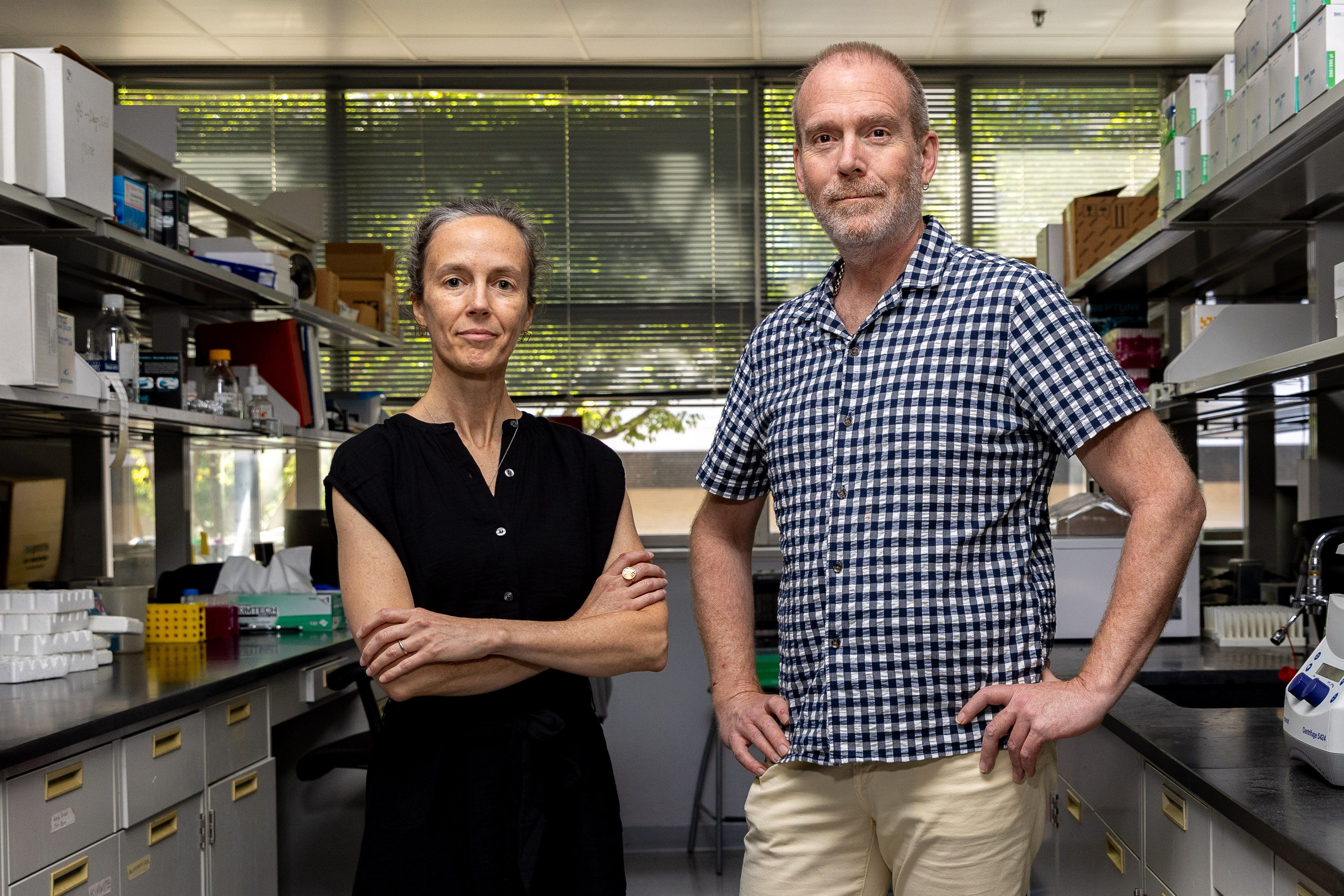All in the family … sometimes
Researchers at the Virginia Institute for Psychiatric and Behavioral Genetics at VCU are deepening the public’s understanding of the impact of substance abuse.

Alexis C. Edwards, Ph.D. (left), and Brien P. Riley, Ph.D. (right), are researchers at the Virginia Institute for Psychiatric and Behavioral Genetics at VCU. Their genetic investigations of substance abuse, suicide and schizophrenia offer hope to patients and families living with a variety of conditions. (Photo by Skip Rowland)
Since scientists first mapped the human genome approximately 20 years ago, a steady current of genetic information and resources have entered the mainstream. From predicting a patient’s likelihood of experiencing side effects from a medication to geolocating one’s DNA origins, today a quick swab can produce a slew of data helpful to understanding human health.
But what if the genetic question is more nuanced, difficult to parse and related to potentially life-threatening conditions like psychiatric illness? Searching for those answers is what drives Alexis C. Edwards, Ph.D., and Brien P. Riley, Ph.D., researchers at the Virginia Institute for Psychiatric and Behavioral Genetics (VIPBG) at VCU who investigate substance abuse, suicide and schizophrenia.
Established in 1996, VIPBG initially brought together VCU School of Medicine researchers from human genetics and psychiatry. Today, VIPBG has grown to foster collaborations that span the medical school, VCU College of Engineering and VCU College of Humanities and Sciences, and is one of the numerous research hubs that has made VCU a national leader in the study and treatment of addictions.
Nature versus nurture … versus nature?
While it’s commonplace to say that risks for certain psychiatric illnesses run in families, Edwards and Riley say that’s only part of the story. In fact, quantifying that genetic risk, and understanding where and when it operates, is at the core of what they do.
A genetic epidemiologist, Edwards is concerned with how genetic and environmental factors influence heritable conditions at the population level. In the continuum of genetics research, the findings from Edwards’ inquiries then inform the work of Riley, a molecular geneticist who studies the physical structure of genes related to a particular trait with the goal of developing a therapeutic intervention.
Among Edwards’ research interests is the genetic relationship between Alcohol Use Disorder (AUD) and suicidal behavior. A natural and understandable assumption that many people make is that suicidal behavior happens in the context of depression, Edwards says.
While sometimes true, extensive analysis of multiple Swedish population-based registries – widely recognized to be among the highest quality in the world for research – revealed that a stronger predictor of suicide attempts and death is AUD.
“What we were able to do by looking at these family history records was estimate a person’s aggregate genetic risk for developing a particular disorder. Then we took it a step further by breaking it out by sex,” says Edwards, noting that even though suicide deaths are more common among men, suicide attempts are more common among women.
“One of the major takeaways is that the strength of the association between AUD and suicidal behavior is about 3.5 times higher in women than in men, and remains higher for the rest of their lives,” Edwards continues. “But there’s hope, because this is potentially a causal association, which means that if we can intervene upon AUD early, we might actually be able to lower the rates of suicide.”
Working toward the development of such therapeutic interventions is Riley’s focus.
“If we can identify the genes that are involved, then we have potential targets for designing new drugs,” says Riley, though he’s quick to point out a complicating factor: the DNA itself.
Despite knowing the likelihood of genetic risk, and despite knowing which genes are involved, sometimes finding the exact physical location within the genetic code can present a challenge.
Rare genetic diseases like Huntington’s and cystic fibrosis – that were among the first to be genetically mapped – are diseases that occur when there’s a change in the protein-coding sequence of a gene. Common variants underlying common disorders – including AUD and schizophrenia – primarily affect regulation of the gene’s expression, altering where, when and how a gene is expressed.
“Finding the common variants is challenging, but the vast majority of the risk in the population is derived from common variants, so those are the ones we need to understand to impact disease in the largest number of people,” Riley says.
Promising new directions
Looking ahead, Edwards plans to continue studying AUD while asking bold new questions about suicidal behavior related to a variety of medical conditions like cardiovascular disease, specific cancers and dementia.
Similarly, Riley is excited about a promising line of AUD research that is moving the field out of the brain and into the body.
“Most of the research in this area focuses on changes that occur in the brain, but we’ve just started working on genes that are expressed in the liver and the gastrointestinal tract,” Riley says. “This is an important area that we need to pursue.”
If you would like to learn more about opportunities to support mental health research at VCU Health, contact Heather Phibbs, director of development, at phibbsh@vcu.edu.